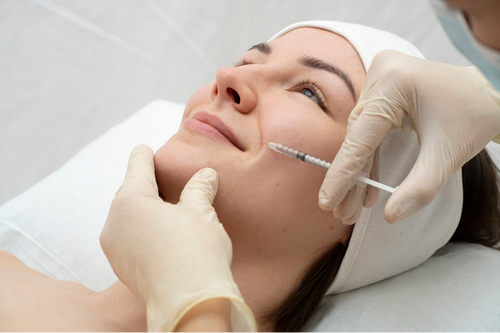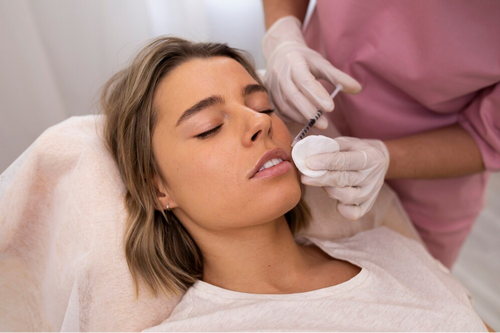
30 Aug Understanding Different Types of Dermal Fillers: A Guide to Facial Rejuvenation Options
Dermal fillers are becoming more popular for people who want to look younger without surgery. These injections from professionals like Transformation Aesthetics can smooth out wrinkles and add volume to your face. There are several types of dermal fillers, each with its own unique properties and uses.

Many patients curious about fillers but unsure where to start. It’s important to know that different fillers work best for different areas of the face. Some are great for plumping lips, while others excel at filling in deep lines around the mouth or eyes.
When thinking about getting fillers, it’s crucial to talk with a skilled doctor. They can help you pick the right type for your goals and explain what to expect. Fillers can give quick results, but they don’t last forever. Most need to be redone every few months to a year.
Key Takeaways
- Dermal fillers offer a non-surgical way to reduce wrinkles and add facial volume
- Different types of fillers work best for specific areas of the face
- Consulting a skilled doctor is key to choosing the right filler for your needs
Exploring the Basics of Dermal Fillers:
What Are Dermal Fillers?
Dermal fillers are gel-like substances injected under the skin. They plump up wrinkles and add volume to areas of the face.
They can smooth out lines around the mouth and eyes. They also enhance cheeks and lips.
Fillers are different from Botox. Botox freezes muscles, while fillers add volume beneath the skin.
Most fillers are temporary. They break down over time and get absorbed by the body. Results usually last 6-18 months, depending on the type used.
The Role of Dermal Fillers in Aging and Aesthetics
As we age, our faces lose fat and bone density. This can create a sunken or hollow look.
Fillers replace this lost volume. They restore a more youthful shape to the face.
They are used to:
- Plumping thin lips
- Softening facial creases
- Improving recessed scars
- Enhancing shallow contours
Fillers offer a quick fix with little downtime. Many people like them as an alternative to surgery.
Different Types of Dermal Fillers
There are several types of fillers. Each has its own pros and cons.
Hyaluronic Acid (HA): This is the most common type. It’s a natural substance found in skin. HA fillers are soft and gel-like. They’re used for lips and fine lines.
Calcium Hydroxylapatite (CaHA): This mineral-like compound is found naturally in bones. CaHA fillers are thicker than HA. They’re good for deeper lines and enhancing cheekbones.
Poly-L-lactic Acid: This synthetic filler stimulates your own collagen production. It works gradually over several months.
Polymethylmethacrylate (PMMA): These are semi-permanent fillers. They contain tiny balls that stay under the skin indefinitely.
Assessing Benefits and Considerations
Dermal fillers offer many advantages for facial rejuvenation. They can improve appearance and boost confidence. But it’s important to weigh the pros and cons before getting treatment.
Enhancing Facial Contours and Volume
Dermal fillers are great for adding volume to areas that have lost fullness. They can be used to plump up cheeks, lips, and temples. This helps create a more youthful look.
Fillers can also improve facial symmetry. They can be used to balance out uneven features, for example to make the jawline look more defined.
The results look natural when done right. People often say they look refreshed, not “done”. The effects can last 6-18 months depending on the type of filler used.
Addressing Wrinkles and Fine Lines
Fillers smooth out wrinkles and fine lines very well. They can be injected into problem areas like smile lines, marionette lines, and forehead creases.
The filler plumps up the skin from beneath. This fills in wrinkles and creates a smoother surface.
Results show up right away. There’s no long recovery time like with surgery. Most people can go back to their normal activities the same day.
Potential Risks and Side Effects
While dermal fillers are usually safe, there are some risks to think about. Common side effects Facial Fillers Carry Rare But Significant Side Effects and Risksinclude:
- Bruising
- Swelling
- Redness
- Tenderness
These usually go away in a few days. More serious but rare risks include:
- Infection
- Allergic reaction
- Lumps or bumps under the skin
- Blood vessel blockage
Talk to your provider about possible risks before treatment.
The Procedure of Administering Fillers
Dermal filler injections involve several steps to ensure safety and optimal results.

Initial Consultation and Goals Assessment
It is best to start by meeting with the provider to discuss your goals and expectations. Your medical history and medications should be reviewed. Then the face is examined, noting areas of concern and skin quality assessed. Together you decide on the best filler type and treatment areas. Potential risks and benefits should be explained , and any questions answered.
Photos are often taken to document the pre-treatment appearance. This helps to compare results later. The costs and any follow-up appointments that may be needed should also be discussed.
Injection Techniques and Areas
Before injecting, the treatment area should be cleaned. thoroughly. A topical anesthetic to reduce discomfort may be used.. Some fillers contain lidocaine, which helps numb the area during injection.
Various injection techniques are employed depending on the area and desired outcome:
- Linear threading for lips and fine lines
- Fanning for cheeks and temples
- Cross-hatching for deeper wrinkles
Common treatment areas include:
- Nasolabial folds (smile lines)
- Marionette lines
- Cheeks
- Lips
- Under-eye hollows
The filler is injected slowly and carefully, often massaging the area to ensure even distribution.
Understanding Recovery and Aftercare
After the procedure, some swelling, redness, and bruising are normal. These usually fade within a few days. Patients are often advised to:
- Apply ice to reduce swelling
- Avoid touching or massaging the treated areas for 24-48 hours
- Skip makeup for 24 hours
- Avoid strenuous exercise for 24-48 hours
- Stay out of extreme heat or cold for 2 weeks
Most patients can return to normal activities right away. Full results are typically visible within 1-2 weeks.
Schedule a follow-up appointment to check results and address any concerns
Achieving Long-Term Satisfaction
Dermal fillers can provide lasting results when used properly.
Some fillers last longer than others. Hyaluronic acid fillers often last 6-12 months. Calcium hydroxylapatite can last up to 18 months.
Poly-L-lactic acid stimulates collagen and can last 2 years or more.
Your provider should explain the pros and cons of each option. They’ll help you pick a filler that matches your desired look and longevity.
Maintaining Results and Follow-Up Care
After getting fillers, proper care helps them last. Providers often suggest avoiding intense heat or cold for a few days. Don’t massage the treated area unless instructed.
Follow-up appointments are key. Your provider can check your results and suggest touch-ups if needed. They may recommend maintenance treatments to keep your look fresh.
Good skin care also extends filler life. Use sunscreen daily. Stay hydrated. A healthy lifestyle supports your skin’s health.
Conclusion: Embracing the Change Confidently
- Fillers offer a minimally invasive way to refresh your look. With the right approach, you can enjoy long-lasting results.
- Be open with your provider about your goals. Ask questions if you’re unsure. Remember, subtle changes often look most natural.
- Fillers aren’t permanent like surgery, but that’s often a plus. You can adjust your treatment as your face changes over time.
- With proper care and follow-ups, you can maintain your new look confidently. Embrace the positive change fillers can bring to your appearance and self-esteem.
Resources:
- https://www.aad.org/public/cosmetic/wrinkles/fillers-overview
- https://www.plasticsurgery.org/cosmetic-procedures/dermal-fillers
The information on MedicalResearch.com is provided for educational purposes only, and is in no way intended to diagnose, cure, or treat any medical or other condition.
Some links may be sponsored. Products, included compounded prescriptions above are not warranted or endorsed.
Always seek the advice of your physician or other qualified health and ask your doctor any questions you may have regarding a medical condition. In addition to all other limitations and disclaimers in this agreement, service provider and its third party providers disclaim any liability or loss in connection with the content provided on this website.
Last Updated on August 30, 2024 by Marie Benz MD FAAD
